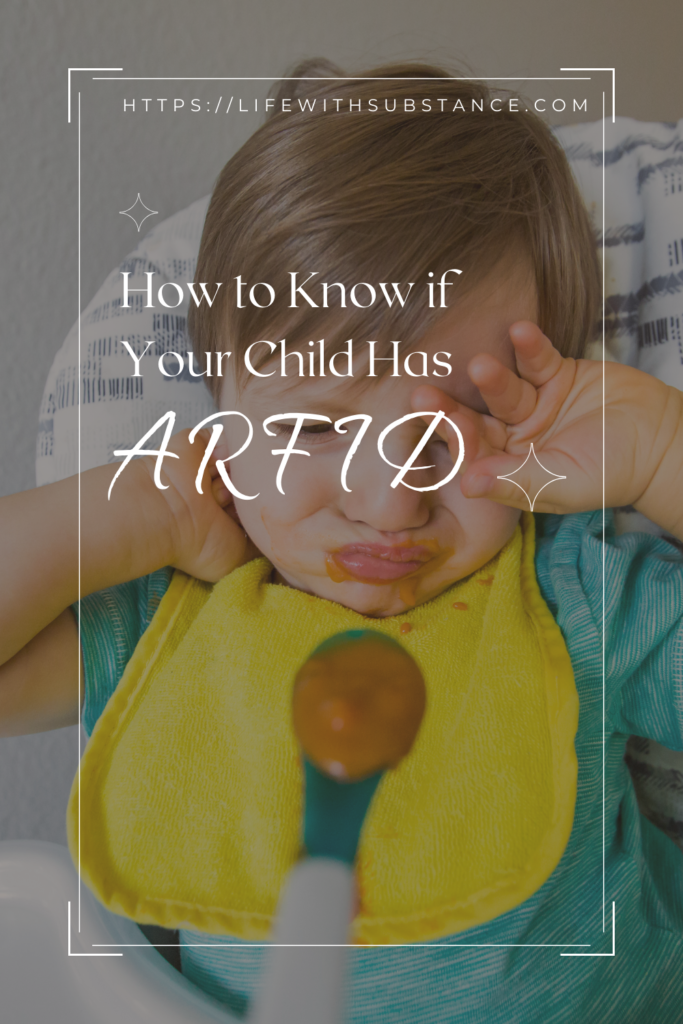This post may contain affiliate links. If you shop from one of our links, we may earn a commission.
As parents, we all know the struggle of dealing with a picky eater. It can be frustrating and concerning when your child refuses to eat certain foods or shows a lack of interest in trying new foods. However, what if these behaviors are not just a phase but are indicative of a more serious condition known as Avoidant Restrictive Food Intake Disorder (ARFID)? In this blog post, we will explore the differences between picky eating and ARFID, the symptoms of ARFID, the causes behind this disorder, and the treatment plan options available for children who may be struggling with it.
Understanding the Basics of Picky Eating and ARFID
Navigating the dinner table with young children often involves a familiar dance of coaxing, negotiating, and sometimes, outright standoffs over uneaten plates of food. This scene is not uncommon in households across the globe, as many children exhibit a natural phase of selective eating. This reluctance to try new foods or certain types of food falls within the spectrum of typical early childhood behavior.

ARFID versus Picky Eating
On the flip side, Avoidant Restrictive Food Intake Disorder (ARFID) takes this normal picky eating to an entirely different level, where the avoidance of food and restrictive eating patterns significantly interfere with a child’s physical health and emotional development. This is more commonly found in those with autism spectrum disorder, attention deficit hyperactivity disorder, intellectual disabilities, and those with anxiety disorders, but no always. While it is more commonly diagnosed in children, adults too can struggle with ARFID. It has also been found to be more common in males.
Understanding the distinction between these two is crucial for parents. While it’s normal for children to show hesitation toward green vegetables or a newfound disdain for previously loved foods, ARFID involves a more profound, often anxiety-driven avoidance that can lead to significant nutritional deficiencies and impact a child’s growth. It’s the intensity and the consequences of these eating behaviors that set ARFID apart from typical picky eating.
Recognizing the Symptoms of Avoidant Restrictive Food Intake Disorder
Identifying the symptoms of Avoidant Restrictive Food Intake Disorder (ARFID) in your child can be the first step towards understanding and addressing their unique challenges with food aversions.
Unlike other eating disorders such as anorexia or bulimia, ARFID patients do not exhibit body image issues. Instead, the disorder is displayed in three subtypes:
- Restrictive Subtype: Decreased interest in eating or low appetite
- Aversion Subtype: Eliminates certain foods due to sensory sensitivities
- Avoidant Subtype: Restricted intake due to a traumatic event or fear of a traumatic event such as choking or vomiting
Other Symptoms Children with Avoidant Restrictive Food Intake Disorder Exhibit:
- Significant reluctance or food refusal, which can lead to significant weight loss or a noticeable failure to achieve expected weight gain on growth charts.
- Display a persistent disinterest in engaging with a variety of foods or outright avoid new foods, driven by deep-seated anxiety around mealtime scenarios.
- One of the hallmark signs of ARFID includes extreme picky eating behaviors that go beyond simple food preferences, affecting the child’s nutritional health and emotional well-being. These children might also show signs of distress, such as crying or tantrums when confronted with food situations that challenge their limited eating patterns.
- Sensory issues often play a role, making the texture, smell, or appearance of certain foods particularly aversive. This avoidance isn’t just about disliking flavors; it’s about an ingrained aversion that can seem insurmountable to the child.
- It’s also vital to note that ARFID’s impact extends beyond the dinner table. The disorder can influence their social life and family dynamics, as children might withdraw from social activities involving food or exhibit increasing anxiety around meal times. Recognizing these symptoms early can pave the way for timely intervention and support, offering a lifeline to families navigating the complexities of ARFID.

Getting a Proper Diagnosis: Working with a Professional
When concerns arise about your child’s eating habits and the potential for ARFID, getting professional help from a healthcare provider becomes a critical step who can provide an ARFID diagnosis if appropriate. A comprehensive evaluation is essential, as it goes beyond observing mealtime behaviors to dig into a detailed assessment of your child’s nutritional health, growth patterns, and psychological well-being.
This process may involve a team of specialists, including pediatricians, psychologists, occupational therapists, and dietitians, each bringing a unique perspective to understand the full scope of your child’s eating challenges. They will gather information through interviews, dietary logs, and possibly medical tests to rule out other conditions that could be affecting your child’s appetite or food intake, such as allergies or gastrointestinal issues.
This holistic approach ensures that any diagnosis of ARFID is accurate, taking into account the complexity of your child’s relationship with food. Engaging with these professionals not only paves the way for a clear diagnosis but also opens the door to tailored strategies and interventions designed to support your child’s nutritional and emotional needs.
Unpacking the Causes Behind ARFID
Deciphering the complex web of factors that lead to ARFID requires a multifaceted approach, as no single cause has been pinpointed. This condition may stem from a blend of biological, psychological, and socio-environmental elements that uniquely influence each child.
Psychological aspects, particularly anxiety disorders, are also significant contributors, with some children experiencing overwhelming fear or anxiety about the act of eating, the consequences of eating, or the sensory experience of certain foods.
Moreover, children with heightened sensory sensitivities might find specific textures, tastes, or smells intolerable, further restricting their willingness to engage with a variety of foods. Environmental factors, such as family mealtime dynamics or past negative experiences with food (like choking or severe gagging), can exacerbate these challenges. It’s a tapestry of influences that demands a comprehensive understanding and approach to effectively support children grappling with ARFID.
When to Worry About Your Child’s Picky Eating
As your journey through parenthood unfolds, you’ll likely encounter phases where your child might be less than adventurous at the dinner table. While it’s a common part of growing up, there are moments when picky eating could hint at something more, such as ARFID. Understanding when to transition from patience to concern is crucial.
It’s time to take a closer look if your child’s selective eating habits result in noticeable nutritional gaps, if they express an intense fear or anxiety about eating, or if their food preferences sharply limit their ability to participate in social settings. Additionally, if your child’s picky eating has persisted far beyond what would be considered a developmental phase—impacting their physical growth or leading to weight loss—it’s a sign that professional insight is needed.
These scenarios indicate a departure from typical picky eating, suggesting that underlying issues may be contributing to your child’s restrictive eating patterns. Observing and acknowledging these signs early can be instrumental in seeking timely, effective support and guidance for your child.
Treatment Plan Options for ARFID
Navigating the treatment options for a child with ARFID involves a personalized and multi-faceted approach, tailored to meet their unique needs.

Working with a Trained Psychologist
One of the core components of an effective treatment plan includes cognitive behavioral therapy (CBT), which helps children understand and manage the anxieties and behaviors associated with ARFID. This therapy can empower them to gradually face their fears of eating and learn coping strategies that encourage a healthier relationship with food.
Working with a Trained Occupational Therapist
Additionally, occupational therapy plays a pivotal role, especially for those children dealing with sensory sensitivities that make certain textures, smells, or tastes particularly challenging. Occupational therapists use specialized techniques to desensitize children to the sensory aspects of foods, making meal times less daunting.
An integral part of ARFID treatment also involves the careful and gradual introduction of new foods, guided by professionals in a non-threatening, supportive environment. This step-by-step exposure helps broaden the child’s diet at a pace that feels manageable for them, reducing the stress associated with eating and encouraging a more varied intake of nutrients.
Working with a Trained Dietitian
For some children, nutritional supplements may be necessary to bridge the gap in their diet, ensuring they receive enough calories and the essential vitamins and minerals needed for healthy growth and development. Collaboration with pediatric dietitians who specialize in ARFID is key to developing a balanced dietary plan that supports the child’s physical needs without exacerbating their ARFID symptoms.
This collaborative, supportive approach ensures a comprehensive strategy that not only addresses the immediate nutritional needs but also fosters a healthier, more positive approach to food and eating in the long term.
How to Support Your Child and Yourself Through This Journey
Navigating your child’s journey with ARFID can be a profound challenge, filled with both concern and hope. As a parent, your unwavering support and understanding play a critical role in your child’s recovery. Embrace a compassionate stance, celebrating small victories and acknowledging the courage it takes for your child to face food-related fears.
Meanwhile, don’t overlook your well-being. Engaging in self-care practices and tapping into resources for parents can offer the resilience and strength you need. Connecting with communities of other parents facing similar challenges can also provide comfort and practical advice. By approaching this path with empathy, patience, and informed strategies, you’ll not only bolster your child’s progress but also foster a nurturing environment where healing and growth can flourish.
Is your child struggling with picky eating? Grab my free complete picky eating guide to navigate feeding your little one.

